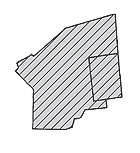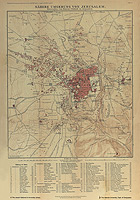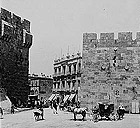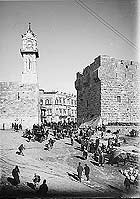The Ottoman Period, the Ottoman City Wall, 1517-1917 CE
|

|
The Ottoman city wall encompasses the area we know today as the Old City of Jerusalem and it is the latest of the walls that were built in the city.
The Ottoman wall was built at the start of the Ottoman imperial rule in the Land of Israel, an era that continued for about four centuries. At the beginning of the period Jerusalem was a derelict city, as was the case during the Mamluk period. Later, with the establishment of the Ottoman Empire and the expansion of its sphere of influence to the west, the Ottomans began to invest resources in the Empire that included, among other things, large building projects.
In the Land of Israel the Ottomans also implemented changes and modifications in the area of government and administration which affected the economy, agriculture and commerce of the entire country. Jerusalem was affected by these changes and the general state of the city improved, especially during the reign of Sultan Suleiman the Magnificent, who ruled from 1520-1566.
Suleiman the Magnificent carried out several building projects in Jerusalem, among them: he built the city walls, rehabilitated the waterworks and decorated the outside of the Dome of the Rock with Kashani tiles. Of the three major construction projects Jerusalem's city walls have left the greatest mark on the city's appearance since then.
It is commonly assumed that when the Ottomans arrived in the country in 1516 the wall in Jerusalem was breached and in ruins and just a few remains survived in the area. Suleiman's court architect, Sinan Pasha (dubbed Kuja Mimar - the great architect), was given the job of planning the new wall. Taxes the Ottomans collected in Egypt went to fund the construction. Abraham Castro, a Jew who served as minister of finance and 'master of the mint' in Egypt, was responsible for the implementation of the work.
It is estimated that the construction of the wall lasted three to four years.
Arabic inscriptions indicating that dates of its construction are fixed in various places in the wall. The inscription in Jaffa Gate states:
"In the name of Allah the merciful and the compassionate, our lord the great sultan, king of the Turks, the Arabs and the Persians, Suleiman Ben Salim Khan, ordered that this blessed wall be built, may Allah will perpetuate his reign, Year 945" (AH).
M. Ben-Dov 1983, p. 85
The inscription in the northern wall commemorates the construction that took place in the years 1537-1538:
"The construction of this wall was ordered by our lord the sultan, Suleiman Ben Sultan Salim Khan, in the year 949" (AH).
Z. Vilnay 1969, 1980, 3281-3282
To this day the reason the city walls were erected are still not known for certain. It is commonly believed, as E. Schiller and others have suggested, that the function of the city wall was not primarily military; rather it was meant to delimit the Holy City on the one hand, and protect its residents against raids by Bedouins and marauders on the other. This is attested to by among other things, the thickness of the walls, which at just 2.5 m wide is substantially less than that of the Hasmonean city walls that were 4-5 meters thick, and this is despite the fact that at the time the walls were being built cannons were already an essential weapon in warfare.
M. Ben-Dov proposes two other reasons for the construction of the city wall: 1) to protect against a renewed crusade by Carlos V, King of Spain, out of fear he wanted to conquer Jerusalem and 2) to reinforce Jerusalem from a religious standpoint so as to strengthen Muslim interests over the Christian interests in the city and thus "to win the encouragement of the vanquished Muslim population" (M. Ben-Dov 1983. P. 85). And in another place, "Jerusalem's fortifications were meant to promote the military goals of defending the city against powerful regular army forces and therefore their plan is excellent and many resources were invested in their construction. But no less important than this was the holiness of Jerusalem in the eyes of Islamů "(Ibid. p. 99).
These reasons explain the aesthetic effort that was invested in the fortification work including the planning and the execution (Ibid. p. 85). Here too there are those who believe that Jerusalem's walls were constructed modestly and with great savings as can be seen by the minimalist route that was selected and the building materials that were utilized which made great use of stones taken from ancient buildings.
Whether these are the reasons or not "future generations however considered Suleiman's act an expression of honor and homage for Jerusalem, and an attempt to increase its importance" (E. Schiller 1991, p. 45).
Despite the fact that the construction of the wall and its fortifications was not completed as the citadels, wall towers and decorations indicate, the construction of the walls greatly impacted the city's image and the nature of the construction within it, and the number of residents in it which increased from 10,000 to 16,000 in the year 1540 (Ibid.).
Upon the death of Suleiman the Magnificent and the ascent to the throne by Suleiman Selim II (1560-1574) there was a significant decline in all aspects of life in Jerusalem; construction was halted and the city walls were neglected and no longer maintained. By the middle of the seventeenth century development in Jerusalem came to a halt and its importance declined further in the following centuries.
During the nineteenth century construction inside the old city was mostly focused near the city walls and the gates, regions which until then were uninhabited, probably, because they were somewhat marginal, relatively remote and it was difficult to reach the market, the city center and the main roads from there.
The city walls were no longer being maintained in the latter part of the Ottoman period. In various places individuals took over sections of the wall for personal reasons and dismantled stones for construction purposes which resulted in extensive damage to the walls. The situation was also exacerbated owing to the fact that the city walls were not then (nor are they today) the responsibility of the different sects who could not be bothered to look after them. Toward the end of the Ottoman period (1830-1917) residents began leaving the safety of the Old City walls which greatly influenced the image of Jerusalem and its character. This development included extensive expansion into the areas north and west of the Old City and Jewish, Moslem and Christian construction outside the city walls.
During the first phases of the 'exodus from inside the walls' shops and residential buildings were constructed in the area outside the Jaffa Gate and along the road that leads to it. The buildings were erected up against the western wall which served as their back wall and concealed the city wall (the structures no longer exist today, but their 'footprints' can be seen in a number of places on top of the city wall).
Significant changes were made to the city walls during this period, among them:
- In 1889 the New Gate (also called 'Abd el-Hamid Gate' or 'The Sultan's Gate') was opened which was used by the residents of the Christian Quarter in moving between their dwellings in the Christian Quarter and the public buildings outside the city walls.
- In 1898, prior to the visit of the German Emperor Wilhelm II, the city wall was breached next to Jaffa Gate, the moat that was at the foot of the Citadel was filled in and a road was paved that led to Jaffa Gate and the Old City.
- At the end of the 19th century changes were made in Herod's Gate (Flower Gate) that included sealing the eastern entrance of the 'Plain Postern' and breaching a northern opening in order to allow a wide, straight entry into the Old City.
Finds:
The city walls
Historical Sources:
The most important source of the period is the book by the judge Mahir a-Din al-Almi (1456-1521) telling the history of Jerusalem and Hebron.
Remarks:
Lions Gate probably dates to the time of Baybars and its stones include the reliefs of leopards which were later used by the Ottomans.
The question of the walled city is discussed at length in Ben-Dov, M. 1983, pp. 71-72.
|
|

|
| The route of the Ottoman wall |

|
| Jerusalem on the Minster Map 1550. The line of the eastern and northern wall can be seen on the map. |
The Jewish National and University Library and the University of Jerusalem, Department of Geography, Historic Cities Research Project
|

|
| Jerusalem on the survey map of 1864/65 |
The Jewish National and University Library and the University of Jerusalem, Department of Geography, Historic Cities Research Project
|

|
| A new entrance - the breach in the wall near Jaffa Gate, circa. 1898-1914 |
Matson Photographic Collection
|

|
| The vicinity of the breach after the removal of the buildings next to the wall and the sabil, but prior to the removal of the clock tower circa. 1898-1934 |
Matson Photographic Collection
|
|















